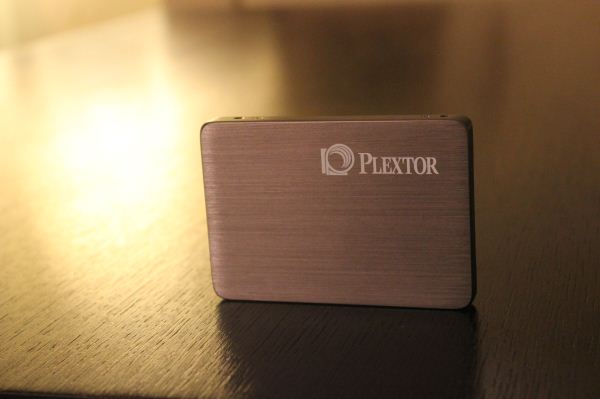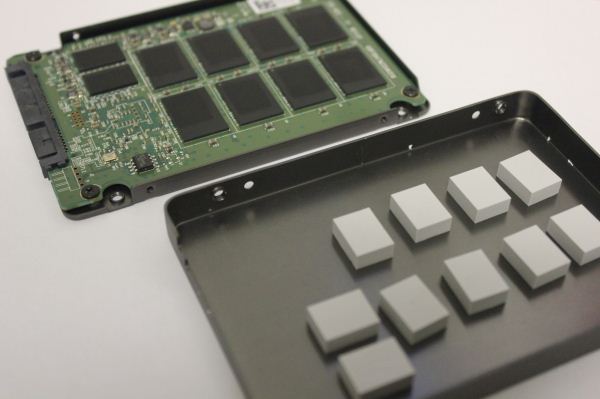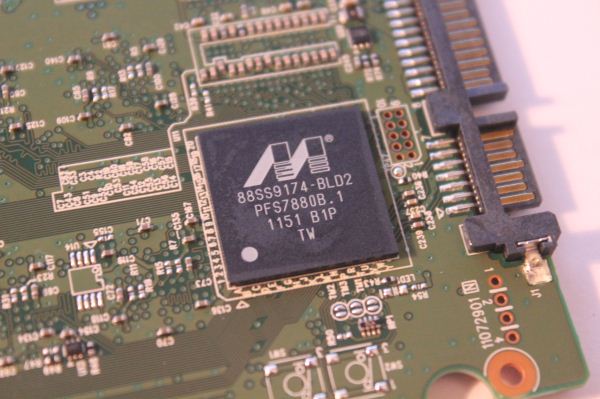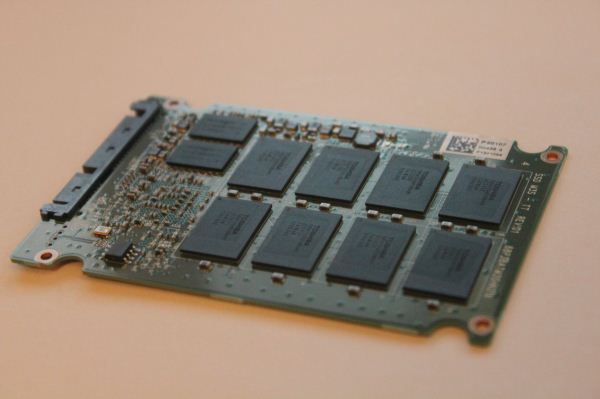The Plextor M3 (256GB) Review
by Kristian Vättö on April 5, 2012 3:05 AM ESTThe Plextor M3
Plextor sent us a 256GB model of their M3 series. Below is a table containing the specifications of their M3 line.
| Plextor M3 Specifications | ||||
| Model | PX-64M3 | PX-128M3 | PX-256M3 | PX-512M3 |
| Raw NAND Capacity | 64GiB | 128GiB | 256GiB | 512GiB |
| Formatted Capacity | 59.6GiB | 119.2GiB | 238.5GiB | 476.9GiB |
| Number of NAND Packages | 8 | 8 | 8 | 8 |
| Number of die per Package | 1 | 2 | 4 | 8 |
| Sequential Read | 520MB/s | 510MB/s | 510MB/s | 525MB/s |
| Sequential Write | 175MB/s | 210MB/s | 360MB/s | 445MB/s |
| 4K Random Read | 55K IOPS | 70K IOPS | 70K IOPS | 56K IOPS |
| 4K Random Write | 40K IOPS | 50K IOPS | 65K IOPS | 30K IOPS |
| Cache (DDR3) | 128MB | 256MB | 512MB | 512MB |
The Plextor M3 is available in all the standard capacities. In the light of the performance specifications, the M3 looks very promising. It beats its closest match, the Crucial m4, in all aspects. It's very competitive even with SandForce based SSDs and especially the stated random read figures are great.
| NewEgg Price Comparison (4/2/2012) | ||||
| 64GB | 128GB | 256GB | 512GB | |
| Plextor M3 | $110 | $180 | $340 | $660 |
| Crucial m4 | $88 | $155 | $315 | $630 |
| Intel 520 Series | $110 | $180 | $345 | $800 |
| Samsung 830 Series | $105 | $185 | $300 | $780 |
| OCZ Vertex 3 | $90 | $178 | $340 | $770 |
Price wise the M3 is not the cheapest SSD, especially in the smaller capacities. There is about $10-15 premium in the 64GB and 128GB models but 256GB and 512GB models are more competitively priced. Crucial's m4, however, comes in as a cheaper option than the M3 at every capacity so that will be a key matchup where Plextor has to win on performance or come down in pricing.
The external design of Plextor M3 is very solid. When I first saw it, it reminded me of Samsung 830 with its brushed metal finish. Only the Plextor logo has been printed on the front—The model and other important information are printed on a sticker on the back of the drive. The drive package includes a 3.5" bracket, quick installation guide, and a software CD, which includes a clone&backup utility along with performance analyzer. Plextor is giving the M3 a top notch 5-year warranty as well.
Each of the main components (controller, NAND devices, and DRAM) have their own little thermal pad. Since the chassis is also made out of metal, heat dissipation should not be a problem.
Inside we find Marvell’s 88SS9174-BLD2 controller (or just 9174). This is the same controller that's in Crucial's m4, but the firmware is custom developed by Plextor. It’s actually a bit surprising, yet very refreshing, to see a Marvell based SSD for a change. Everyone seems to have a SandForce solution these days. We have seen that Marvell can be competitive; you just need to take the time to customize the firmware to get good performance. The stock SandForce firmware is fast enough, so it's obvious that many companies choose to go with the easiest option.
Flip the PCB and we find eight Toshiba 24nm 2-bit-per-cell MLC NAND devices. That’s coupled with two 256MB DDR-1333 chips from Nanya, giving a total of 512MB of DDR3 cache.
Toshiba uses a Toggle-Mode interface and the current iteration (2.0) of Toggle-Mode NAND is good for up to 400MT/s per interface. Rating speed by transfers is a bit annoying as it doesn't tell us the actual bandwidth—for that we need the width of the channel and transfers per second. The channel in this case is 8 bits wide, so that works out to be 3.2Gbps per interface, or 400MB/s. With eight NAND packages, the maximum throughput works out to be 3200MB/s, over four times more than what SATA 6Gb/s can provide. Of course, reading from NAND and dumping the data into a register is one thing; it's another matter to actually transfer the data to a host controller over the interface.
We want to provide a quick word about firmware updates before we go into benchmarks. The drive came with FW 1.01, which was the latest at that time. Plextor has recently released FW 1.02 which is supposed to fix some issues but all our tests have been done using FW 1.01. Plextor is not claiming increased performance in the release notes of the update. The actual process of updating the firmware is very simple. Download a small ISO (~3MB) from Plextor's site, burn that to a CD or USB stick and boot from that. Press Enter and it automatically flashes the drive. I even had all my other drives plugged in and there was no problem.
The Test
| CPU |
Intel Core i5-2500K running at 3.3GHz (Turbo and EIST enabled) |
| Motherboard |
AsRock Z68 Pro3 |
| Chipset |
Intel Z68 |
| Chipset Drivers |
Intel 9.1.1.1015 + Intel RST 10.2 |
| Memory | G.Skill RipjawsX DDR3-1600 2 x 4GB (9-9-9-24) |
| Video Card |
XFX AMD Radeon HD 6850 XXX (800MHz core clock; 4.2GHz GDDR5 effective) |
| Video Drivers | AMD Catalyst 10.1 |
| Desktop Resolution | 1920 x 1080 |
| OS | Windows 7 x64 |
Our regular readers may notice that my testbed is not exactly the same as Anand's. Anand's setup is based on Intel's motherboard with H67 chipset, whereas mine is an ASRock board based on Intel's Z68 chipset. The important bit here is that both feature native SATA 6Gb/s support and both setups use the same drivers. Other features and components don't really have an effect on SSD testing. For example the average CPU usage during write speed tests is less than 5%.














113 Comments
View All Comments
Kristian Vättö - Friday, April 6, 2012 - link
Oops! Thanks, fixed it now. I added the Vertex 4 scores right before this went live so that's why Vertex 4 is not included in any of the analyses.wvh - Thursday, April 5, 2012 - link
Back at the end of the '90s we used to burn a lot of CDs at university, and only the Plextors lasted and rarely burned coasters. It was the brand to have. In fact, the only writer that hasn't broken down on me yet is my Plextor.This isn't a shill ad – it's just a CD-writer after all – I'm just surprised to hear you've never heard of Plextor.
hrrmph - Thursday, April 5, 2012 - link
I may have missed it, but more emphasis on the inclusion (or lack) of toolbox software and what functions it provides would be appreciated. Preferably near the beginning of the review.When I look at ranking SSDs, the inclusion of toolbox software that supports Secure Erase and possibly even 'settable spare area' is important to me.
I find manual (non-toolbox) methods of Secure Erase to be overly complicated and time-consuming.
So the inclusion of toolbox software that supports Secure Erase, and thus easy maintainability is important.
Settable spare area is also nice, because I'm willing to buy an SSD that is the next size up just to get some more spare area, because reliability is extremely important to me.
So when reading a review, while it's nice to know that the manufacturer took the time to provide good firmware and good validation (I'm not sure that validation was well-covered in this review either), it's also very nice if I can quickly 'suss out' whether the manufacturer took the time to make a good toolbox.
To my knowledge, only Intel, OCZ, and Samsung provide a toolbox that allows for easy Secure Erase from inside Windows, assuming the drive is connected to a machine as a secondary drive.
Similarly, I think that only Samsung is allowing settable spare area in their toolbox.
I usually eliminate OCZ from consideration these days because Intel and Samsung provide very adequate alternatives, and most importantly, I saw OCZ forum moderators horribly and publicly abusing some of the other OCZ customers. So while I wasn't abused by OCZ when I was a customer of theirs, I saw the potential.
Coming back to reviews, AT still writes the best reviews in my opinion. I like the non-emotional tone, and the long length, detail, and insightful analysis included in the reviews make them stand out from the crowd.
Other review sites tend to miss even basic points, or worse, they get breathlessly emotional and sensationalist over small differences in the various products. I think AT knows when something is worth getting worked up over, and when it's just run of the mill.
My understanding of the review, is that the Plextor M3 256GB is run of the mill.
I hope I'm not missing something here :).
-
Anand Lal Shimpi - Thursday, April 5, 2012 - link
i agree wholeheartedly - Samsung's toolbox is definitely the new gold standard here. I've been pushing folks behind the scenes to ramp up the quality of their options as well. I want to start paying more attention to it as it's a huge part of the user experience.Take care,
Anand
Kristian Vättö - Friday, April 6, 2012 - link
Unfortunately, there is no toolbox software included in Plextor M3. I have to say I'm not a fan of secure erase either, especially during write tests because this is starting to feel like work!I'll definitely try to concentrate more on the software in future reviews as several readers have requested it :-)
Coup27 - Friday, April 6, 2012 - link
I'm a massive Samsung fan and I have a contact there who says Samsung will be releasing an updated ssd magician either this month or next which will also report ssd life like Intels do. Think they realised disabling the smart values to do it yourself was a mistake, esp if u want to put one in a server.cooldadd - Thursday, April 5, 2012 - link
Kristian, I commend your writeup. New and capable talents are welcome in this arena... You will certainly have a chorus of voices with earlier/other perspectives, but they in their own way will bring you "up to date" on history prior to your entry into the mix!We are living in an amazing frenzy of technical advancement. Thirty years into the development of the telephone, for instance, not only would few people have been able to have technical discussions over its progress, but there was no popularly-available medium in which to discuss it!
I discovered AnandTech when it was new, sixteen years into my mainframe career, started by a young person like yourself who happened have a sharp technical curiosity and an ability to write well. I hope your contributions will follow in similar fashion.
Bozo - Friday, April 6, 2012 - link
I must be getting old...Back when burnable CDs came out you needed a SCSI burner like 'Smart & Friendly' to make more good CDs than coasters. Then Plextor introduced one of the first PCI burners that actually made more good CDs than coasters. It was the CD burner to have if you were serious about making usable CDs.
I feel old.
sbmeirow - Friday, April 6, 2012 - link
If you haven't heard of Plextor, then you are a newbie, and I don't read articles written by n00b's.Coup27 - Friday, April 6, 2012 - link
Idiot.